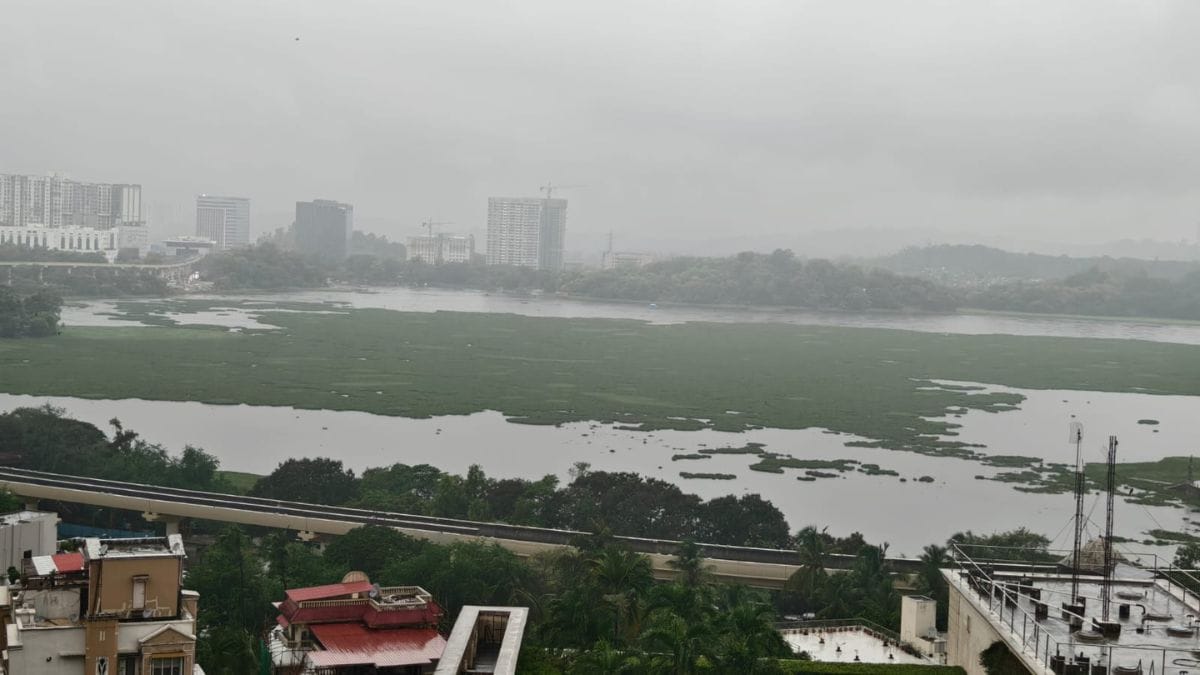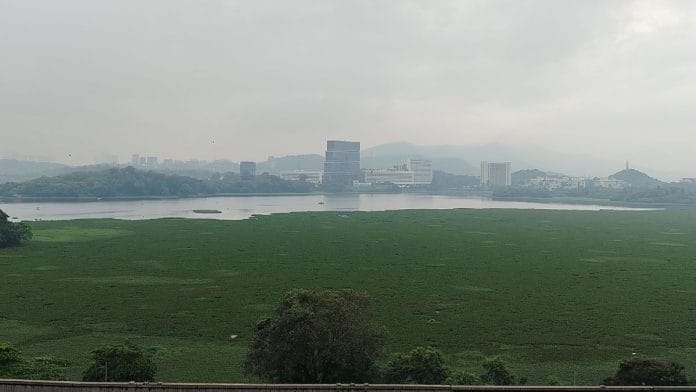Mumbai: After a long battle, residents of Mumbai’s Powai have registered a win and propelled the Brihanmumbai Municipal Corporation (BMC) to finally clean up the 6.6-square kilometre Powai Lake, which runs from Sanjay Gandhi National Park in the north to IIT-Bombay in the south.
The lake, an urban ecosystem in the densely populated residential area, protects a rich biodiversity, including migratory birds, fish and crocodiles. It also offers an area for recreational activities to residents and is visited by tourists.
Despite being an artificial lake, the Powai wetlands also play a crucial role in mitigating floods by serving as an ecological buffer.
However, since 2021, the lake has been covered by weeds such as hyacinth, blocking sunlight to aquatic life, and has seen the steady flow of untreated sewage into its waters. According to Additional Municipal Commissioner for Projects Abhijit Bangar, at least 18 Megaliters per Day (MLD) of sewage enters the water as a result of drainage.
There have been several previous attempts to clean the lake, with the government failing to act on a directive from the National Green Tribunal (NGT) three years ago.
On 21 May, in a victory for the residents, the BMC floated two tenders to clean up the waters—one to divert the sewage line and the other to install eight MLD sewage treatment plants (STP)—before monsoon begins in the first week of June.
This was after Powai’s Advanced Locality Management (ALM) members, with the help of the environmental non-profit NatConnect Foundation, launched an online petition on 17 May titled ‘#SavePowaiLake,’ which received close to 3,000 signatures, urging the BMC to remove hyacinth from the lake’s waters.
As part of their efforts, Powai residents mailed Chief Minister Devendra Fadnavis and BMC chief Bhushan Gagrani to look into the issue. Residents also continued to email, message, and call officials of the area.
Finally, Bangar intervened to get the hyacinth cleared from the lake, deploying harvest cutting machines at the site.
According to Bangar, speaking to ThePrint, of 18 MLD of infested water, eight MLD will be treated at the lake site with the new STP, and the remaining ten MLD will be diverted to the larger STPs in Mumbai, such as the ones in Bhandup and Mithi river.
Also Read: How Mumbai civic body is using AI to hold contractors accountable during pre-monsoon desilting
Citizen movement stands strong
According to B.N. Kumar, director of NatConnect Foundation, a non-profit that works on environmental and conservation projects, the NGT had directed the government to clean the lake in 2022.
The directive was passed after a year-long legal battle between the environmental non-profit Vanshakti and the BMC over environmental degradation and unauthorised construction in Mumbai. Ruling in favour of the Vanshakti, the NGT directive said that all the wetlands in Mumbai should be cleaned, and the sewer water entering the Powai Lake must be stopped.
However, the government did not take any action in that regard.
“The action was only on paper. All the VIPs, ministers, MLAs, MPs, and officers saw the condition of the Lake, yet there was no action. Had the order been implemented, things would not have gone to such a level,” Kumar told ThePrint.
Then this year, members of Powai’s ALM decided to take matters into their own hands. ALMs are citizen-led platforms that allow residents to pool resources and help service providers maintain a locality’s services transparently.
Milan Bhat, who lives in Hiranandani Gardens, said, “After witnessing the excessive growth of hyacinth in the water, the ALM devised a campaign strategy, as the cleanup kept getting delayed. This lake is the pride of Powai. Earlier, I used to see the moon’s reflection on the lake for a peaceful night. It was that clear. But today, it stands covered, and I can’t see anything. This is very painful.”

Residents from societies such as JalVayu Vihar and Hiranandani Gardens formed a core part of the committee.
The ALM also brought NatConnect Foundation on board as the non-profit, along with Navi Mumbai Environment Protection Society and Save Flamingos and Mangroves forum, was instrumental in saving the DPS Flamingo Lake in Navi Mumbai, which has now been declared a conservation site.
Speaking to ThePrint, Pamela Cheema from Powai’s JalVayu Vihar Society and chairperson of the ALM said, “I have lived in Powai for 24 years, but no campaign to save Powai Lake has worked out. This lake, a favourite tourist hotspot in Mumbai, is our pride. The situation’s urgency was that we could see it was like a green carpet and was getting worse. We were determined to do something about it and got Mr Kumar onboard.”
Youth from the area also joined the initiative, taking up the job of spreading awareness about the issue on their online networks through Facebook, X and WhatsApp and the media.
BMC’s challenges
In the BMC’s defence, Bangar told ThePrint that the civic body has said it periodically keeps removing hyacinth from Mumbai’s water bodies, but it keeps spreading as sewage water finds its way into the water bodies.
Speaking to ThePrint, Bangar said the civic body has removed nearly 25,000 MT of hyacinth from the lake in the past six months. He attributed the leading cause of the rapid hyacinth growth to the sewage water increasingly flowing into the lake.
“We have two ways of getting rid of the hyacinth—one is physical, the other is through sewage water treatment. However, physical removal is easier said than done.”
Nearly four harvest-cutting machines have been installed in the past week at the lake, with the fifth one to be added this week. “We will add the sixth machine to expedite the process within two to three months, and have also sought help from the BNHS. One work order has been issued for next week, and the next one will be issued in the first week of June,” Bangar told ThePrint.
The residents of Powai are happy about their win, but their battle is far from over. They claim that the steps taken by the BMC are too little, too late.
They want the BMC to find a permanent solution to the hyacinth problem by figuring out how to treat the sewage water seeping into the lake.
“The challenges we encountered were many. Be it bureaucratic lethargy or local apathy, people are not just bothered. Unless every person in the seat stands up and shouts, the authorities will not listen. We have to keep demanding accountability from the officials,” Kumar said.
With the upcoming BMC corporator elections, he said people should make the environment an essential election issue.
“There are officials who are in charge of these things. So why can’t the officials, who get paid from the taxpayers’ salaries, be made accountable for it?” Kumar added.
When Bhat, who has a young son, looks at the lake, she can only think of two things—its peaceful aura and safeguarding the future interests of the next generation.
“I don’t want our children and the next generation to face this because of our neglect. They don’t deserve this. We need to be very responsible about preserving our biodiversity. The youth should also come forward because they are the next torchbearers and must understand the importance of preservation,” Bhat added.
Pooja Bhatia is an intern with ThePrint.
(Edited by Sanya Mathur)
Also Read: Only 1 of Mumbai’s 24 wards gets round-the-clock water supply—Praja Foundation report







There are serious encroachments on the north western part (Aarey) . That is the part where sewage and filth enters.